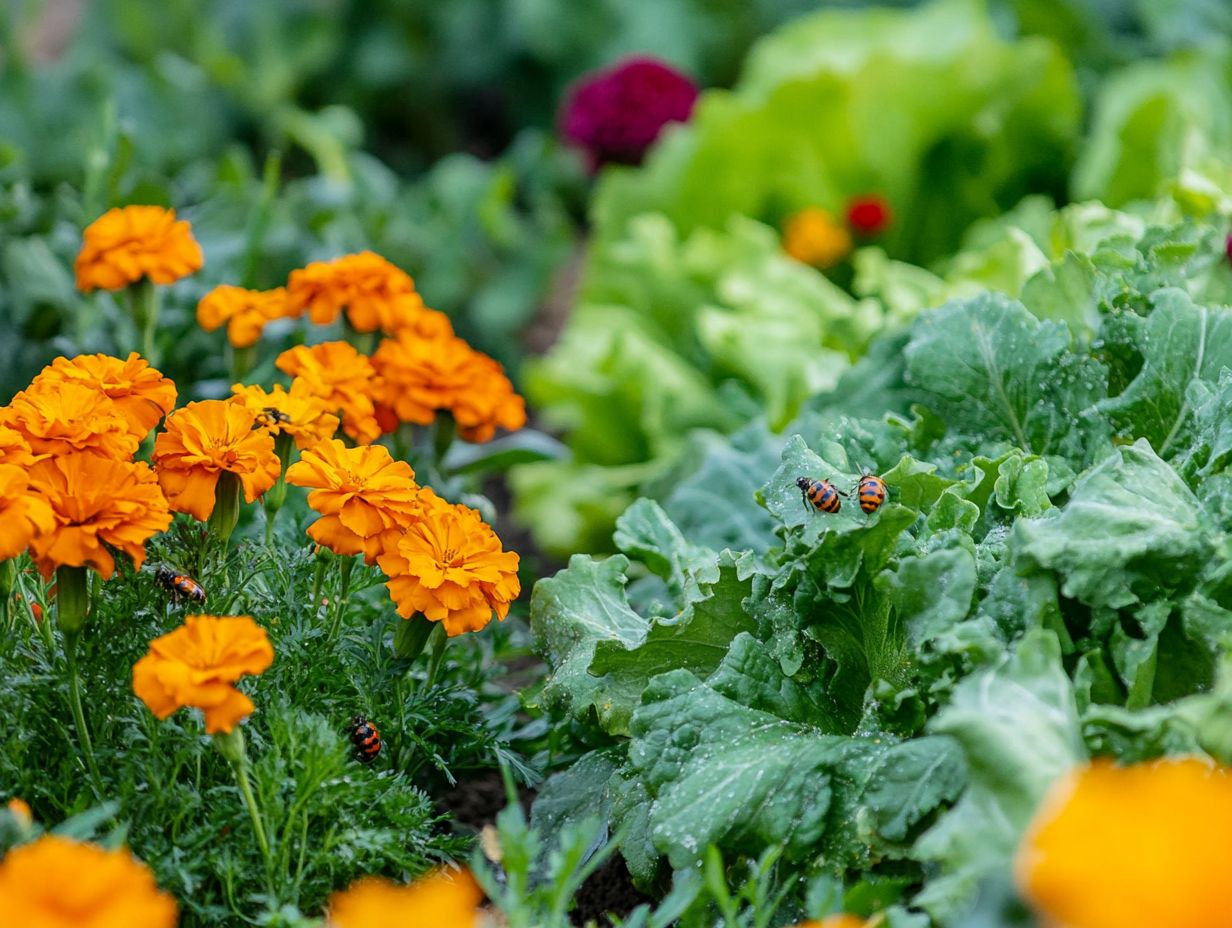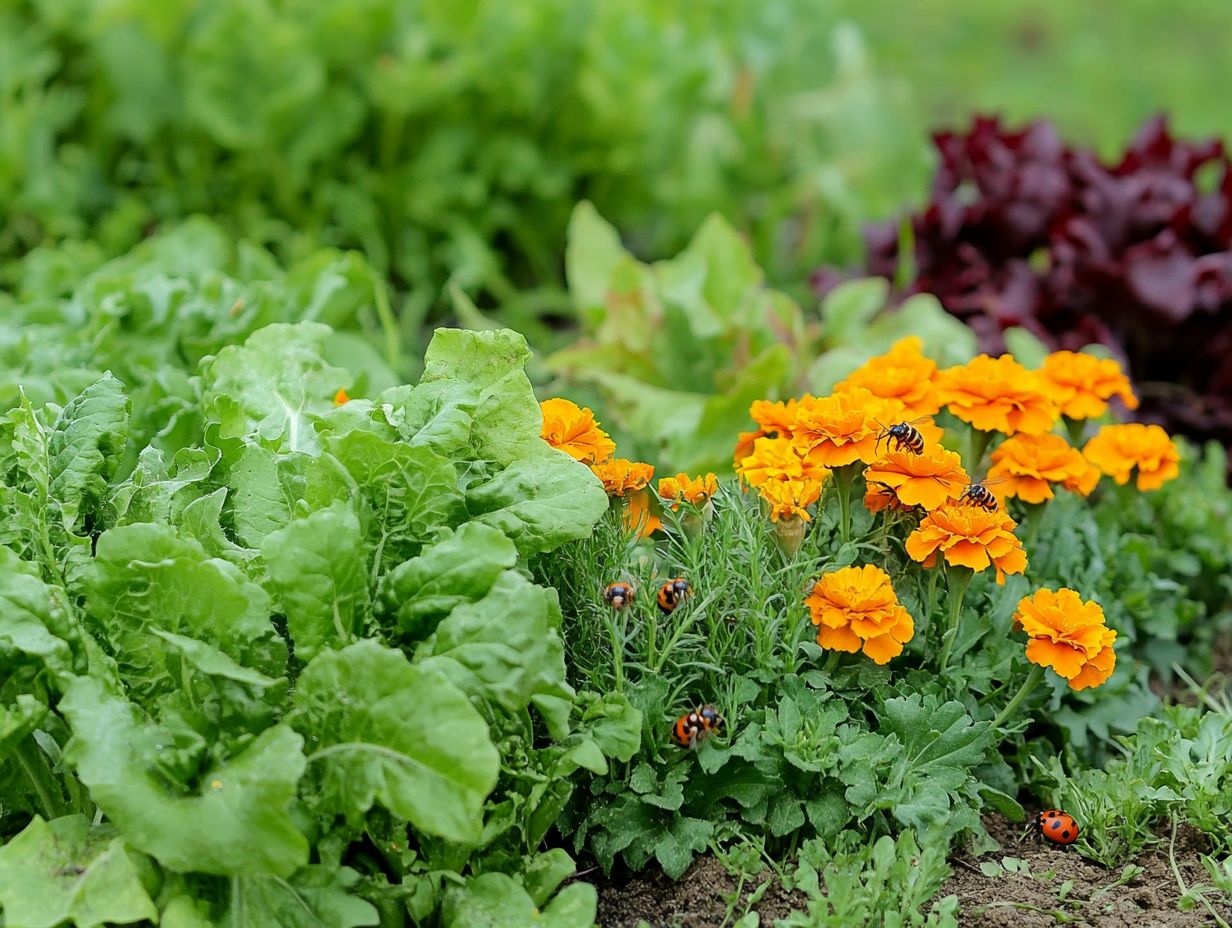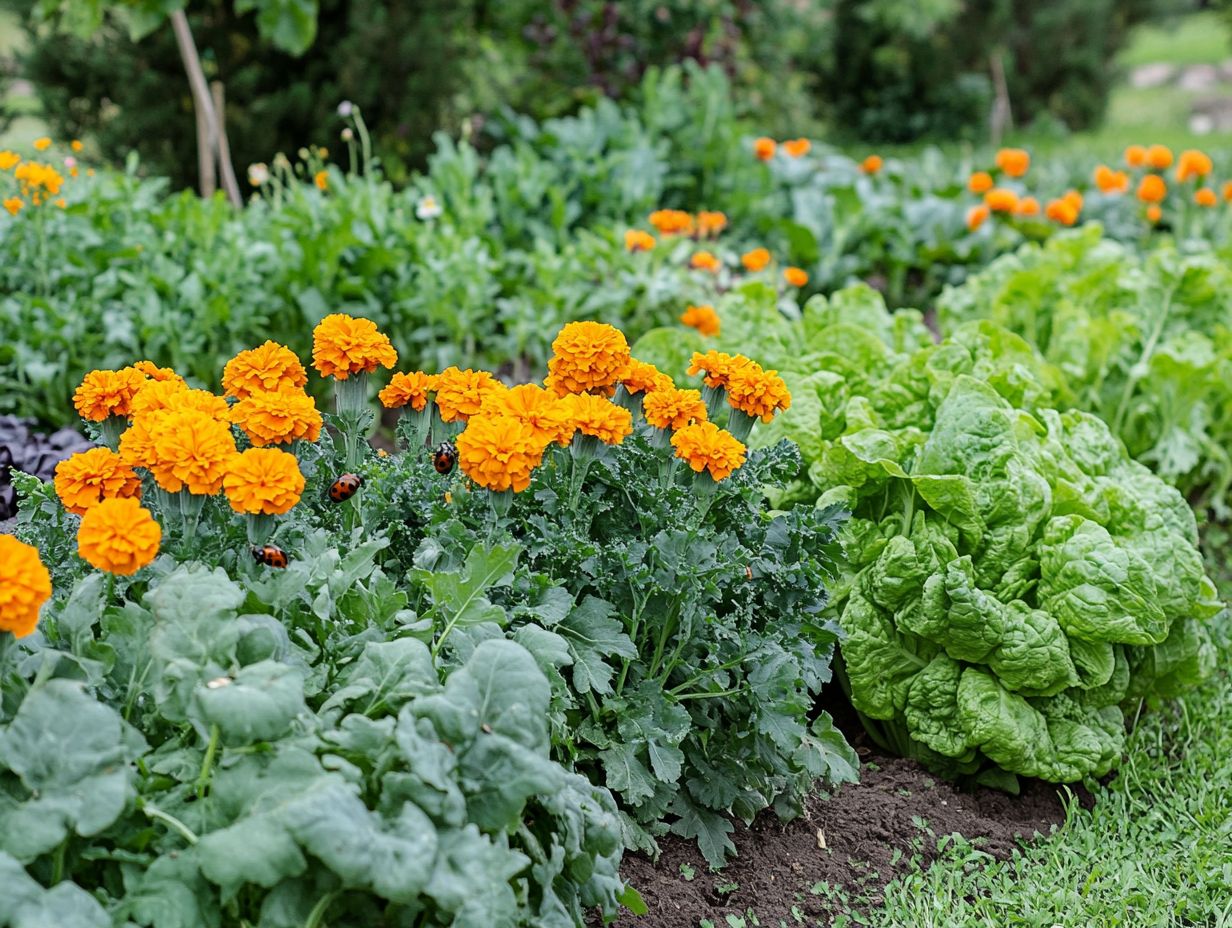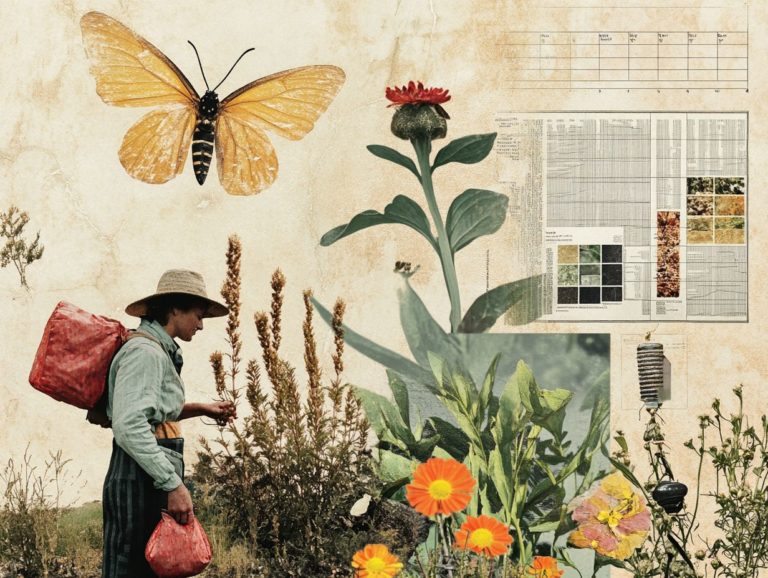How to Use Companion Planting for Pest Control
Companion planting is a timeless gardening technique that taps into the natural relationships among plants to enhance growth and improve the overall health of your garden. This method provides valuable benefits for pest control, showcasing how specific plant pairings can serve as natural deterrents, helping you minimize dependence on harmful chemicals.
You’ll find practical tips for designing your own companion planting garden, focusing on compatible plants and effective planting strategies. You’ll also discover some effective plant pairings that can elevate your garden into a flourishing ecosystem.
Contents
- Key Takeaways:
- Benefits of Companion Planting for Pest Control
- How to Plan and Implement a Companion Planting Garden
- Common Companion Planting Combinations
- Frequently Asked Questions
- What is companion planting and how can it be used for pest control?
- Which plants can I use for companion planting to control pests?
- How do I incorporate companion planting in my garden for pest control?
- Are there any plants that should not be planted together for companion planting?
- Can companion planting completely eliminate the need for pesticides?
- Are there any other benefits to using companion planting besides pest control?
Key Takeaways:

What is Companion Planting?
Companion planting is a remarkable sustainable gardening practice that gives you the power to strategically pair different plants, enhancing your garden s health and boosting overall yields. This method not only diversifies your plant life but also creates inviting habitats for beneficial insects, which help with natural pest control.
Knowing how different herbs and vegetables interact can help you optimize your garden layout while employing organic strategies to keep pests away. Rooted in traditional agricultural practices, this technique has been cherished for centuries across cultures. The significance of companion planting in organic gardening is immense, as it helps plants grow better together, reducing the need for chemical pesticides.
Different plant species often reap rewards from each other’s presence, enhancing nutrient uptake, providing shade, or repelling harmful insects. Take the pairing of tomatoes and basil, for instance it not only elevates flavor but also attracts helpful insects like ladybugs and lacewings, which are allies in natural pest control.
Utilizing resources like companion planting charts can provide you with valuable insights, enabling you to make informed decisions. This method helps keep nature in balance and significantly contributes to sustainable gardening efforts, encouraging a holistic approach to food production.
Benefits of Companion Planting for Pest Control
Companion planting presents a wealth of advantages for pest control, making it a critical strategy for anyone aiming to cultivate a thriving and healthy vegetable garden. Additionally, understanding the benefits of crop rotation for pest control can further enhance your gardening efforts. By embracing natural pest control methods like planting herbs that keep pests away or flowers that draw in beneficial insects, you can significantly reduce reliance on chemical solutions.
This method protects your crops and makes your gardening more eco-friendly. Start using these natural methods today to see healthier plants tomorrow!
Natural Pest Deterrents
Natural pest deterrents play a crucial role in companion planting, as certain plants come equipped with unique properties that repel harmful insects while inviting beneficial ones. Take marigolds, for instance; they not only add a splash of color to your garden but also keep pesky aphids at bay. Meanwhile, aromatic herbs like mint and rosemary serve as effective natural repellents against a range of pests.
By incorporating these plants into your vegetable garden, you cultivate a harmonious environment that lessens your dependence on chemical pesticides. Basil, for example, not only enhances the flavor of your tomatoes but also wards off flies and mosquitoes.
Garlic is another formidable ally you can interplant among your crops to deter a wide array of insects. By thoughtfully selecting combinations, you can create an ecosystem that attracts helpful predators like ladybugs and lacewings, ultimately promoting robust plant health.
This strategy not only ensures a bountiful harvest but also champions a sustainable approach to gardening, minimizing your environmental footprint.
Reduced Need for Harmful Chemicals

One of the key advantages of companion planting is its remarkable ability to lessen your reliance on harmful chemicals often found in traditional pest control methods. By embracing organic techniques and a diverse array of plants, you can create an amazing environment that naturally resists pests. This significantly reduces the need for chemical interventions and promotes a healthier garden ecosystem.
This holistic approach boosts biodiversity and encourages beneficial insects, resulting in a self-regulating ecosystem. As your plants work well together, they repel pests while attracting pollinators, leading to better yields and healthier crops.
By adopting sustainable gardening practices like companion planting, you nurture the soil, conserve water, and create a balanced habitat for various species. These methods enhance the overall health of your garden, minimize pest issues, and improve resilience, fostering a vibrant environment for both your plants and local wildlife.
How to Plan and Implement a Companion Planting Garden
Planning and implementing a companion planting garden requires thoughtful consideration of how plants interact and the optimal layout of your garden. You must also choose compatible plant combinations.
By assessing the growth habits and needs of various species, you can craft a dynamic vegetable garden that uses space and resources efficiently while amplifying the benefits of companion planting.
Choosing Compatible Plants
Choosing compatible plants is essential for the success of your companion planting garden. Some plants work well together, enhancing growth and keeping pests at bay. For example, planting basil and tomatoes near each other not only elevates their flavor but also attracts beneficial insects that help manage pest issues.
Selecting the right pairings can significantly boost plant health and yield. Marigolds, for example, make an excellent companion for nearly any vegetable. Their vibrant flowers attract ladybugs and other pollinators while repelling nematodes that threaten roots. Don t overlook rosemary it can be your secret weapon against the pesky cabbage moth when paired with cabbage.
Incorporating flowering plants and aromatic herbs into your garden enhances its visual appeal and fosters a balanced ecosystem, creating a haven for beneficial insects. By carefully choosing your companions, you cultivate a thriving environment that naturally keeps pests at bay while promoting healthy plant development.
Strategic Planting Techniques
Implementing strategic planting techniques is crucial for maximizing the benefits of companion planting while ensuring effective garden maintenance over time. Techniques like crop rotation and incorporating diverse plants preserve soil fertility and create an inviting environment for beneficial insects while deterring harmful pests.
By adopting interplanting methods growing different crops closely together you can further optimize your space and promote biodiversity. This approach enhances flavor profiles and yields while disrupting pest life cycles, making it more challenging for pests to take root.
Layering is another innovative strategy that allows for efficient use of vertical space, creating a microclimate that benefits various plants while minimizing weed pressure.
Through these thoughtful practices, the overall health of your garden improves, fostering an ecosystem that thrives and provides bountiful harvests season after season.
Common Companion Planting Combinations

Common companion planting combinations can elevate the health and productivity of your vegetable garden, offering natural pest resistance and enhanced growth.
By strategically pairing complementary herb plants with vegetables, you cultivate a thriving ecosystem that benefits both plant and insect life, resulting in a more resilient and flourishing garden.
Start your companion planting journey today! Try these combinations in your garden for an incredible harvest!
Examples of Beneficial Plant Pairs
Beneficial plant pairs show how companion planting can boost your garden’s health and enhance pest control. For example, marigolds are great companions for tomatoes, as they repel pesky squash bugs. Similarly, parsley attracts beneficial insects when paired with various vegetables.
These combinations not only coexist; they actively promote each other s growth. Take basil, for instance it s an exceptional companion for tomatoes. Its delightful aroma masks the scent of tomato plants, confusing pests and keeping them away.
The bold presence of chives planted near roses also deters aphids, helping those delicate blooms stay vibrant and healthy.
These symbiotic relationships safeguard vulnerable plants and enrich the soil quality. This helps you create a thriving environment that’s ripe for growth.
Frequently Asked Questions
What is companion planting and how can it be used for pest control?
Companion planting means growing different plants together to help each other. It can control pests by using plants that repel them or attract beneficial insects.
Which plants can I use for companion planting to control pests?

Plants like marigolds, basil, and mint repel pests such as aphids, mosquitoes, and flies. Other plants, like dill and fennel, attract beneficial insects like ladybugs and lacewings, which prey on pests.
How do I incorporate companion planting in my garden for pest control?
You can interplant different species throughout your vegetable garden or create designated beds for companion plants. Planting herbs and flowers around the perimeter acts as a natural pest barrier.
Are there any plants that should not be planted together for companion planting?
Yes, some plant combinations should be avoided. For instance, planting onions and beans together can inhibit each other’s growth. Research compatibility based on pest behavior before planting.
Can companion planting completely eliminate the need for pesticides?
In some cases, yes! Using companion planting can lower the number of pests in your garden and reduce the need for chemical pest control. However, for severe infestations, additional measures like pest traps may be necessary, and you might also consider how to use essential oils for pest control.
Are there any other benefits to using companion planting besides pest control?
You ll love how companion planting boosts your garden’s health! It can improve garden health, increase pollination, and provide shelter for your plants. Plus, it enhances the flavor of certain vegetables and herbs, creating a more sustainable gardening practice.
Ready to get started with companion planting? Dive into your garden today!






